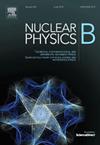Epicyclic oscillations, particle collisions, emission energy and thermal fluctuation around a black hole with de-sitter core
IF 2.5
3区 物理与天体物理
Q2 PHYSICS, PARTICLES & FIELDS
引用次数: 0
Abstract
This study tested the geometric structure and dynamic behavior of particles around a non-rotating black hole (BH) featuring a de Sitter core. We derive the space-time metric and analyze key features such as the lapse function, effective potential, innermost stable circular orbits (ISCOs), and particle trajectories. The Hamiltonian framework reveals that the de Sitter core radius R significantly influences particle dynamics: a larger R shifts the effective potential minima closer to the horizon, enhances the attractive effective force and marginally impacts the ISCO radii. Numerical solutions of motion demonstrate modified trajectories compared to Schwarzschild BHs, with a higher center of mass energy (CME) near the horizon for larger R. Harmonic oscillation frequencies, periastron precession, and thermodynamic properties, including temperature, specific heat, and Hawking radiation emission, are quantified. Thermodynamic stability is tested for specific parameter ranges, with the temperature decreasing as R increases. Our results explain the relation between the de Sitter core and gravitational dynamics, providing insight into the stability and energy properties.
具有非西特核心的黑洞周围的周转振荡、粒子碰撞、发射能量和热涨落
这项研究测试了以德西特核为特征的非旋转黑洞(BH)周围粒子的几何结构和动态行为。我们推导了时空度量,并分析了失效函数、有效势、最内层稳定圆轨道(ISCOs)和粒子轨迹等关键特征。Hamiltonian框架表明,de Sitter核半径R对粒子动力学有显著影响:较大的R使有效势极小值更靠近视界,增强了吸引有效力,对ISCO半径有轻微影响。与史瓦西黑洞相比,运动的数值解显示了修正的轨迹,在视界附近有更高的质能中心(CME), r更大。谐波振荡频率、近星体进动和热力学性质,包括温度、比热和霍金辐射发射,都被量化了。在特定参数范围内测试热力学稳定性,温度随R的增加而降低。我们的结果解释了德西特核和引力动力学之间的关系,提供了对稳定性和能量特性的深入了解。
本文章由计算机程序翻译,如有差异,请以英文原文为准。
求助全文
约1分钟内获得全文
求助全文
来源期刊

Nuclear Physics B
物理-物理:粒子与场物理
CiteScore
5.50
自引率
7.10%
发文量
302
审稿时长
1 months
期刊介绍:
Nuclear Physics B focuses on the domain of high energy physics, quantum field theory, statistical systems, and mathematical physics, and includes four main sections: high energy physics - phenomenology, high energy physics - theory, high energy physics - experiment, and quantum field theory, statistical systems, and mathematical physics. The emphasis is on original research papers (Frontiers Articles or Full Length Articles), but Review Articles are also welcome.
 求助内容:
求助内容: 应助结果提醒方式:
应助结果提醒方式:


